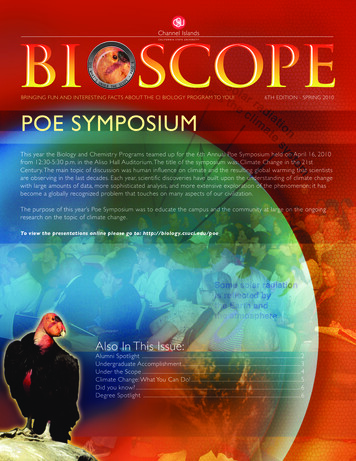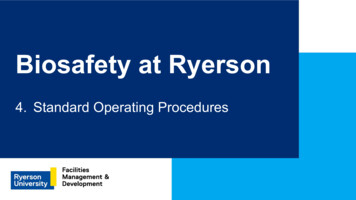
Transcription
Biosafety at Ryerson4. Standard Operating Procedures
Training Outline infection controlcontainment of aerosolsworking in CL1 areasworking in CL2 areasbiological safety cabinetshuman blood and body fluidsneedle stick injury prevention signs and labelsperson protective equipmentpurchasing/transferinventory controldecontamination/waste disposallarge scale work
Infection ControlGood microbiological practice: is a basic code of practice to handle biological agents involves specific sterile techniques of product protection andcontamination control is applied to all types of work involving microorganisms irrespective ofcontainment level to reduce the risk of exposure and infection
Infection ControlGood microbiological practices prevent contamination of: laboratory workers the environment experimental samplesGood work practices can significantly reduce the risk of: aerosol production contamination of surfaces & equipment exposure to biological agents infection
Infection Control: Hand WashingWhen to wash? before starting any manipulations before and after completing any task in a biosafety cabinet every time gloves are removed before contact with one’s face or mouth before leaving the lab at the end of the day .and of course, when hands are obviously soiled
Infection Control: Hand WashingFrequent hand washing has proven to be the singlemost effective means of avoiding infection if doneproperly and frequently.Liquid dispensers should be used rather than barsoaps.
Proper Hand Washing Techniques1.2.3.Wet hands with warm waterDispense soap into a cupped handSpread around hands and between fingers as follows:4.5.6.Wash hands for at least10 secondsRinse thoroughly underwarm waterDry hands thoroughlywith paper towels
Containment of Aerosols
Containment of Aerosols Aerosols are gaseous suspensions of fine solid or liquid particlesranging in sizes from 0.01 to 100 µm and can remain suspended in airfor extended periods of time.Pathogens such as viruses and bacteria are so small that they cantravel within one aerosol droplet and be dispersed by buildingventilation.Aerosols can settle on many surfaces where personnel may unwittinglybe exposed to a potentially infectious material through the risk of directcontact.
Containment of Aerosols You cannot see the aerosol particles (the largest of them being1/10th of a millimeter). Must become aware of what processes can generate aerosols.When in doubt, assume aerosols are generated.When conducting procedures that create considerableaerosols or when using agents classified as requiringContainment Level 2, work should be conducted in a BiologicalSafety Cabinet (BSC).When appropriate, other primary barriers such as splashshields, face protection or gowns should also be used.
Containment of AerosolsThe generation and dispersal of aerosols must beminimized and controlled. Numerous procedures and devices which can result inthe generation of aerosols include, but are not limited to: pouring liquids using centrifuges, shakers, blenders opening pressurized vessels inserting a hot loop into a culture pipetting, etc.
Containment of AerosolsSterilization of inoculating loops in an open flame may createaerosols which may contain viable microorganisms use a shielded electric incinerator shorter handles minimize vibrations disposable plastic loops are good alternatives
Containment of Aerosols: Pipetting mouth pipetting is prohibitedall biohazardous materials should be pipetted in a BSCnever force fluids out, use ‘to deliver’ pipettesto avoid splashes, allow discharge to run down dispense the receivingcontainer wallnever mix material by suction and expulsionreusable pipettes should be placed horizontally in a disinfectant filledpanautoclave before reuse
Working in ContainmentLevel 1 & 2 Areas
Working in CL 1 areasThe following requirements are basic for any laboratory using biologicalagents: good microbiological laboratory practices intended to avoid therelease of infectious agents a documented procedural (safety) manual must be available for allstaff and its requirements followed the manual must be reviewed and updated regularly
Working in CL 1 areas Prohibited: eating, drinking, smoking storing food or utensils applying cosmetics inserting or removing contact lenses oral pipetting loose long hair: must be tied back or restrainedDoors to laboratories must not be left open (does not apply toan open area within a laboratory).
Working in CL 1 areas Laboratory must be kept neat and clean (good housekeeping).Storage of materials not pertinent, and that cannot be easilydecontaminated, must be minimized.Paperwork and report writing should be kept separate from biological workareas.Access to laboratory and support areas is limited to authorized personnel.Extreme caution must be used when handling needles and syringes to avoidautoinoculation and the generation of aerosols during use and disposalNeedles must not be bent or sheared.Disposable needles and syringes must not be replaced in their cap, butplaced into a puncture-resistant container (sharps container).
Working in CL 1 areas Technical procedures must be performed in a manner thatminimizes the creation of aerosols.Work surfaces must be cleaned and decontaminated with theappropriate disinfectant: at the end of the day after any spill of potentially hazardous materialLoose or cracked work surfaces must be repaired or replaced.Contaminated materials and equipment leaving the laboratoryfor servicing or disposal must be appropriately decontaminatedand labelled or tagged as contaminated.
Working in CL 1 areasPersonal protective equipment Laboratory coats must be worn andfastened by all personnel working in thelaboratory.Suitable footwear with closed toes andlow heels, and preferably with non-slipsoles must be worn in laboratory.Protective laboratory clothing must not beworn in non-laboratory areas.Lab coats must not be stored in contactwith street clothing. Keep lab coats in lab & street clothingoutside lab. Suspected contaminated clothing must bedecontaminated before laundering.Eye protection must be worn whennecessary to protect the eyes.Gloves must be worn whenever there is arisk to the skin or risk from absorptionthrough the skin on materials beinghandled. Hands must be washed after gloves areremoved, before leaving the laboratory,and after handling materials known orsuspected to be contaminated, even whengloves have been worn.
Working in CL 1 areasTraining: Lab personnel must receive training on the potential hazardsand the necessary precautions to prevent exposure toinfectious agents and release of contained material. Personnel must show evidence that they understood thetraining provided. Training must be documented and signed by both theemployee and supervisor. Retraining programs should also be implemented.
Working in CL 1 areasDisinfection Disinfectants effective against the agents in use must be available at alltimes within the areas where the biological material is handled or stored.Effective concentrations and contact times must be used.All contaminated materials must be decontaminated before reuse.Efficacy monitoring of autoclaves used for decontamination with biologicalindicators must be done regularly (i.e. consider weekly, depending on thefrequency of use of the autoclave).Records of these results and cycle logs (temperature, pressure) must alsobe kept on file.
Working in CL 1 areasAccidents / IncidentsAll spills, accidents (needle sticks, punctures, cuts, etc.) and overt or potential exposuresmust be reported in writing to the laboratory supervisor as soon as circumstances permit,must file two reports:1. Ryerson University’s “Internal Accident/ Exposure Investigation Report” withEnvironmental Health and Safety (EHS) office within 24 hours of incident2. “Employer’s Report of Injury/Disease (Form 7)“WSIB Form 7” with Human Resourceswithin 24 hours of incidentAppropriate medical evaluation, surveillance, and treatment must be sought and provided asrequired. Actions taken to prevent future occurrences should also be documented.
Working in CL 2 areasIn addition to the safety precautions outlined for Containment Level 1 laboratoryadditional operational practices for CL 2 labs are outlined below: Biological safety cabinets must be used for procedures that may produceaerosols and/or that involve high concentrations or Large Volumes ( 10 L)of biohazardous material/ This could be a single vessel with a volume of 10 litres orgreater, or in some cases, multiple vessels with a total volume of10 litres or greater. Determination of cutoff values for large scalevolumes can be made in consultation with the PHAC or the CFIA/Appropriate door sign must be posted outside each laboratory/
Biological Safety Cabinets
Biological Safety CabinetsBiological Safety Cabinets (BSC) providean effective means of physical containmentfor biological agents, especially whenaerosols are generated.The main role is to provide protection topersonnel, to product, and the environment.
Biological Safety CabinetsProtection is achieved through the control of air movementwithin and prior to leaving the cabinet, and through the use ofHEPA (high-efficiency particulate air) filtration.HEPA filters are designed to remove particles with a minimumsize of 0.3 microns with an efficiency of 99.97%.
Laminar Flow CabinetsLaminar flow cabinets (LFC) are similar in appearance, but arenot Biological Safety Cabinets: only protect the productintake room air which is passed through a pre-filter and a HEPA filterto remove contaminants, dust and other particlespurified air then enters the work surface in a laminar flow(non-turbulent) which is directed out of the cabinet or down intointakesthese cabinets provide product protection only and must not be usedwhen working with any form of biohazardsometimes referred to as Clean Benches
Biological Safety CabinetsCabinet Certification BSCs must be certified annually or after cabinet has beenmoved Laminar flow hoods should be certified every second year undertaken to ensure the HEPA filter has not be damaged,leaking or plugged cabinet should be decontaminated prior to any certificationactivity HEPA filters & cabinets must be decontaminated prior todisposal
Biological Safety CabinetsThe effectiveness of a BSC is dependent upon: the integrity of the cabinet (the risk of exposure increases if the integrity isjeopardized)location of cabinet in a roomproper microbiological technique and work practices that do not disturbestablished airflow velocity and cause reverse currents that can re-introducecontaminants into the work areacontinued maintenance and certification
Biological Safety CabinetsBefore using the cabinet: Ensure BSC is certifiedDisinfect work surfaces with disinfectantPlace essential items inside cabinetAllow the blower to run for 5-10 min before work
Biological Safety CabinetsDuring use of a Biological Safety Cabinet: ensure material and aerosol-generating equipment is placednear the back of the hooddo not block any ventsuse techniques that reduce splatter and aerosolsgeneral work flow should be from clean to contaminated areasminimize movement so as not to impede air flow
Biological Safety CabinetsAfter completion of work: Leave blower on at least 5 minutes to purgecabinetRemove and decontaminate equipment andmaterialsDisinfect cabinet surfacesTurn off blower and fluorescent lamp, turn onUV lamp
Biological Safety CabinetsFlames in Biological Safety CabinetsThe use of flame to sterilize equipment within a BSC is controversial. Anopen flame in a BSC creates several major problems: flame creates turbulence, which disrupts the pattern of air supplied tothe work surface, therefore reducing maximum efficiency heat build-up inside the bsc that may damage the hepa filters creates a fire hazardIt is recommended that flame should not be used in BSC's.Alternatives to flames include using disposable sterile inoculating loops andneedles, or pre autoclaved equipment in sterile packaging.
Biological Safety CabinetsFlames in Biological Safety Cabinets If a flame is required, a touch-plate micro-burner equipped with a pilotlight to provide a flame on demand may be used.This device will minimize internal cabinet air disturbances and heatbuild-up.During use, the heat source should be placed to the rear of theworkspace where resulting air turbulence will have minimal effect.An emergency shut off valve should be placed just outside the BSCgas supply line and during the use of any burner, all combustiblematerials and solvents must be removed.
Biological Safety CabinetsUltraviolet Lamps: Intended to destroy microorganisms in air or on exposed surfaces.Have limited penetrating power and only effective when properly cleaned, maintained.Dust is attracted to the lamps which reduces the transmission of the germicidal effect.Have a limited life span – even if the blue-violet glows, the lamps are not effective if theterminal ends are blackened even slightly.UV lamps themselves are potential hazards since UV light can be harmful to the eyesand skin and should therefore be turned off when work is being conducted in thecabinet.
Biological Safety CabinetsMaintenance of a Cabinet: twice daily: work surfaces wiped downweekly: UV lamp should be wiped cleanmonthly: all vertical surfaces wiped downannually: certification
Human Blood and BodyFluids
Human Blood and Body Fluids blood borne pathogens, which are microorganisms that are present in bloodand bodily fluids and are capable of causing disease in exposed individuals exposure to human blood and bodily fluids (e.g., semen, cerebrospinal,amniotic, etc.), tissue cultures, or organ cultures increases the risk pathogens of greatest concern are hepatitis B virus, hepatitis C virus and theHuman Immunodeficiency Virus (HIV)
Human Blood and Body FluidsRisk of exposure dependent on: pathogen involved type of body fluid route of exposure duration of exposure volume of blood involved in exposure concentration of virus at time of exposure PPE worn
Human Blood and Body FluidsUniversal precautionsThe minimum standard of practice to prevent exposure to bloodborne pathogens, including: education personal protective equipment hand washing safe work practicesUniversal precautions assumes the material to be infectious and required to use controlmeasures to prevent skin and mucous membrane exposure.These precautions must always be used when handling blood or body fluids.
Universal Precautions1.Gloves should be worn when handling potentially contaminated surfaces.2.Avoid touching items that are NOT contaminated when gloves are being worn.3.PPE should be worn during procedures that are likely to generate droplets of blood orbodily fluids.4.Contaminated lab coats and gloves should be removed immediately after procedure iscompleted.5.Hand washing is the most important preventative tool: hands should be washedimmediately after gloves are removed and before leaving a work area.
Needle Stick InjuryPrevention
Needle Stick Injury PreventionInjuries from sharps (needles, syringes, etc.) may result from: lack of training on proper work practicescrowded work conditionsincorrect recapping of non retracting needlespoor disposal practicesRisk of injury exists not only to the user, but also support staff such ascaretaking or hazardous waste disposal personnel.
Needle Stick Injury PreventionShould a needle stick injury occur it is important toreport it immediately and seek a medicalassessment.Such injuries must not be ignored - potentiallaboratory associated infections could developwithout appropriate treatment.
Needle Stick Injury PreventionTo avoid needle stick injury: use needle-less techniques where possibleuse retractable sharpsfill syringes carefullydo not bend, or recap needlesuse approved designated sharps containers should be used for disposal thatwill not allow penetration or direct access to sharps
Signs and Labels
Signs and LabelsBiohazardous or infectious materials fall under:Biohazardous Infectious Material of WHMISClass 6.2 of Transport Canada’s Transportation ofDangerous Goods Act (Infectious Substances)
Signs and LabelsEntrancesBiohazard signs must be posted on doorsto rooms where biohazardous materialsare used (Level 2 or greater)
Signs and LabelsBiohazard labels must also be placed on containers, equipment andstorage units (e.g., fridges, freezers) used for biological agents.
Signs and LabelsInside lab(posted prominently) Internal Ryerson Biosafety PermitCurrent list of authorized users
Personal ProtectiveEquipment
Personal Protective Equipment lab coat (buttoned)disposable glovessafety glassesfootwear (closed toe)Responsibility of both the user and the supervisor to ensure that PPEis appropriately worn and kept in good condition
Personal Protective Equipment Personal protective equipment (PPE) is only effective if correctly selected,fitted, used and cared for, and the individual is trained Criteria for consideration routes of exposure that need to be blocked degree of protection offered specific to each level of containment Ensure PPE is removed before leaving the lab.
Personal Protective EquipmentLab Coats/Gowns long-sleeved, knee lengthbuttoned or ideally with snapsperiodic cleaning requiredlab coat should be worn in lab area only
Personal Protective EquipmentGloves nitrile and vinyl for work with biological agentsavoid latex gloves if possibleconsider tensile characteristics, length of cuffremove gloves when walking in hallwaysdouble glove or do not touch uncontaminated items in labwhen wearing gloves
Personal Protective EquipmentSafety Glasses safety glasses or goggles to protect the eyes
Personal Protective EquipmentFootwear closed toed shoes should always be wornsandals or open toed shoes are not allowed in a biohazard labNO
Purchasing/Transfer
Purchasing ALL PURCHASES OF CL 2 BIO AGENTS MUST BEAPPROVED BY BSO PRIOR TO PURCHASE. Only Certificate Holders or designated authorized users maypurchase biological agents. Import permits required from United States for certain animalor human pathogens. Records of all purchases must be maintained for inspection.
TransferWithin the university prior BSO approval to ensure appropriate containment available unauthorized lending or borrowing of biohazards not permitted between labs
Transfer of Human Cells/TissueOutside the university prior BSO approval for lending or borrowing of biohazards fromother institutions before arrival on campusreceiving institution must have appropriate containmentmaterials must be properly packaged and documentationpersons preparing and/or transporting package must have validTDG Class 6 Training certificateinventory must be adjusted
Inventory ControlPermit Holder must have up to date inventory list of agents onpermit, which will be used by the BSO for inspection. any changes requires a revision to the biosafety permit.find a link on the EHS’ Biosafety webpage
Decontamination & WasteDisposal
Decontamination there is no universal decontamination method for biological materials a spectrum of chemical and physical methods for decontamination exist environmental and other factors can influence efficacy there is a specific vocabulary for decontamination
Decontamination VocabularyDecontamination: Disinfection or sterilization of contaminatedsurfaces and/or articles to make them suitable for useSterilization: Act or process (physical or chemical) that destroys oreliminates all forms of life, especially microorganismsDisinfectant: An agent, usually chemical, that inactivates virusesor kills vegetative microbes but not necessarily resistant forms suchas spores
Decontamination laboratory bench tops, other surfaces, and all equipmentcontaminated with biohazards must be decontaminated priorto reuse, servicing, transfer or disposal procedures must be in place to ensure the effectiveness of themethods used to decontaminate items
Chemical DecontaminationChoice depends on: type of material to be disinfectedorganic loadchemical characteristicsMost common are chlorine compounds and alcohols (broad range)
Chemical DecontaminationChemicals include: 2% -10% domestic bleach (hypochlorite solution) 70% Ethanol quaternary ammonia 6% formulated Hydrogen peroxide 10% formalin 2% glutaraldehyde phenolic compounds
Physical DecontaminationHeat: autoclaving (most practical and recommended) incineration (for disposal of sharps and tissues)Irradiation: UV light (wavelength of 253 nm is germicidal) gamma (disrupts DNA and RNA)Filtration: HEPA (biological safety cabinets, ventilation) 0.2 micron (physically removes particulates )
Sterilization by Autoclaves sterilization is a process which results inthe total destruction of all living and viableorganisms (with a probability of 1 in 1million that 1 organism survived)sterilization is achieved throughautoclavesautoclaves utilize both pressure and hightemperatures to provide an effective wayof sterilizing items
Waste Disposal Ryerson disposes of its biological wastes though a certifiedbiomedical waste disposal company. Such companies collect properly packaged biological wastefor industrial, off-site autoclaving and/or incineration
Waste DisposalIf you currently have solid waste:1. Set up the supplied cardboard boxes with yellow plastic linerand place your bag inside (you can put multiple bags until theyellow liner/box is full)2. Tie up liner, close and tape shut the box3. If your waste contains cytotoxic drugs (i.e., chemo agents), puta “cytotoxic” label on the box4. With a marker, write lab name and date on side of box (e.g.,Smith lab/ Jan 12, 2017)
Solid Waste in Cardboard Boxes
Waste Disposal SuppliesColour CodingYellow for regular biological wasteRed for cytotoxic waste Any material that may have come into contact with acytotoxic drug (such as chemotherapeutic agents) whichinhibit or prevent the function of cells.
Waste Disposal SuppliesPails Use pails to collect waste that could puncture through plasticbags, such as serological pipettes, pipette tips, glass tubes,slides, etc. Use pails to collect liquids: do NOT pour liquids directly intopails, keep liquids in small bottles, then tighten their lids andplace in pails
Waste Disposal SuppliesBoxes with yellow liners For solid waste that cannot puncture a plastic bag (e.g., contaminated gloves,paper towels, unbreakable plastic bottles, etc.) For filled sharps containers
Waste Disposal Supplies Each department will have a location where you can pick up these suppliesー Current locations for Chemistry & Biology department – KHN-202D Call main department to coordinateー Other departments will need to find a common location for supplies orcontact EHSYou can also email ehs@ryerson.ca for more supplies if your departmenthas run out
Waste Disposal Process When boxes are full, tie up liner and tape box closedWhen pails are full, close lid tightly until it clicks (locked –cannot be opened again)Label side of boxes and white lid of pails with Lab name andcurrent date Example: Smith lab / Jan 12
Waste Disposal Process Biological waste pick-up will take place every Monday morning Stay current by checking the EHS’ Biosafety webpage for any updates orchangesEach department will have a location where biological waste can be dropped off Current locations KHN-202D Call Chemistry & Biology department to coordinate
Large Scale Work
Large Scale or High ConcentrationsContainment levels based on laboratory scale operations (inaddition to pathogenicity of agents): increase in containment may be required if working with highconcentrations or shifting to manipulations involving 10 litres increase in the amount of potentially infectious material mayrequire additional safety precautions and/or increase incontainment risk assessment should determine whether there is an increasein aerosol generation
END
Laminar Flow Cabinets Laminar flow cabinets (LFC) are similar in appearance, but are not Biological Safety Cabinets: only protect the product intake room air which is passed through a pre-filter and a HEPA filter to remove contaminants, dust and other particles purified air then enters the work surface in a laminar flow
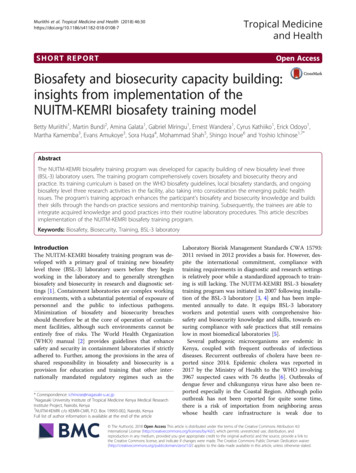
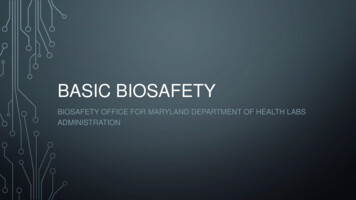
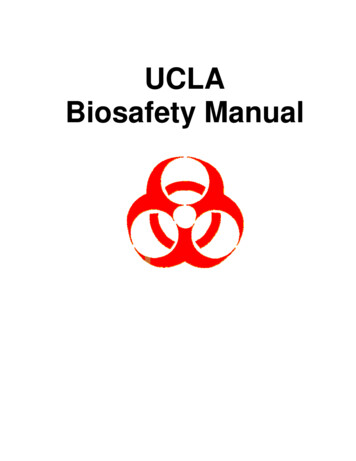
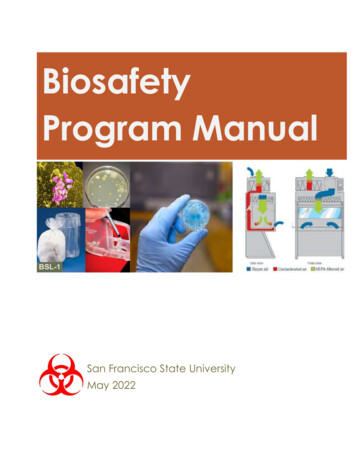
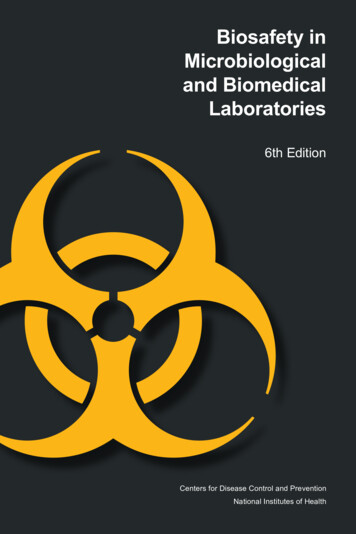

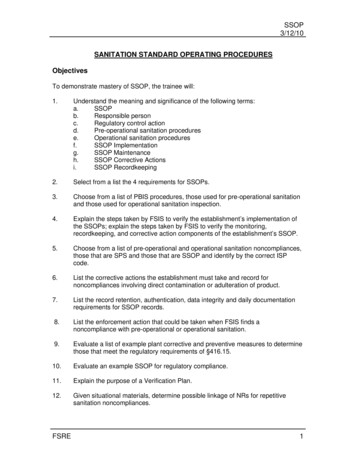

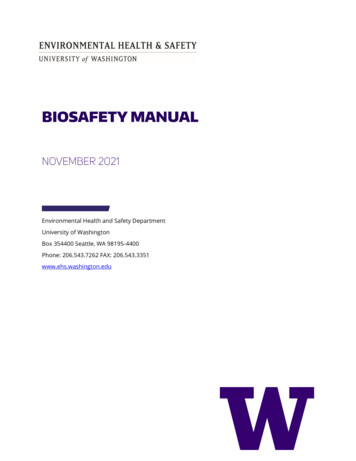
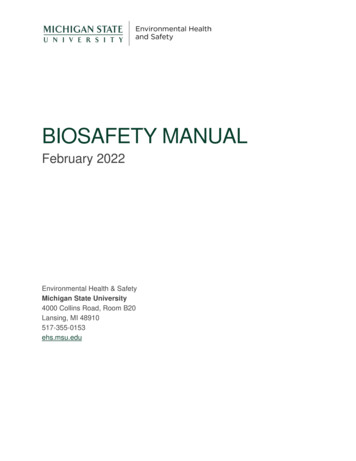
![Biosafety Manual University of Colorado Boulder 120621[80]](/img/25/biosafety-manual-university-of-colorado-boulder.jpg)
